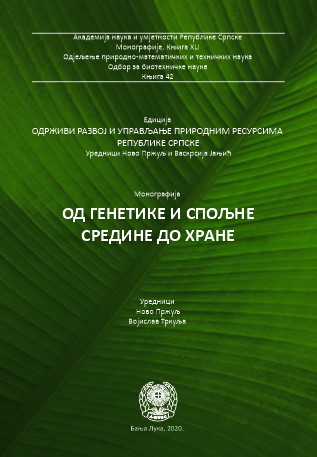Small grain cereals for current and future needs of the Republic of Srpska
DOI:
https://doi.org/10.7251/EORU2001263MKeywords:
Small grain cereals, alternative cereals, varieties, genetic potential, seed production, yield, quality, breeding, agronomyAbstract
Small grain cereals are a basic raw material in human nutrition, an essential element of crop rotation and an integral part of the agricultural strategy of many countries. As a result of breeding work based on the principles of biology and genetics, the genetic potential andhigh yield of most cultivated plant species have been increased. In all cultivated plants, a particularly important factor in achieving high yield is variety, which is why the creation of better genotypes is ofthe paramount importance. The traditional small grain cereals includes bread hexaploid wheat (Triticum aestivum L.), barely (Hordeum vulgare L.), oats (Avena sativa L.) and rye (Secale cereale L.). The definition of alternative cereals is relative. This group includes those plant species grown on small areas or not cultivated at all, and which may represent a substitute or alternative for commercially distributed small grain cereals. Alternative plant species have a regional character, as what is alternative in one region may not be in another, respectively. The alternative cereals include einkorn (Triticum monococcum L.), emmer wheat (Triticum dicoccum L.), spelta (Triticum spelta L.), khorasan wheat (known under the KAMUT brand), and club or compactum wheat (Triticum aestivum ssp. compactum). In the broader sense, the group of alternative cereals includes durum wheat (Triticum turgidum ssp. durum) naked oats (Avena nuda), naked barley (Hordeum vulgare ssp. nudum) and triticale (X Triticosecale Wittmack). The importance of small grain cereals are reflected in the nutritional value, biological plasticity and the possibility of cultivation in different agro-ecological conditions, as well as more modest requirements towards cultivation conditions in comparison with other species. All small grain cereals have winter and spring forms, but as a result of breeding work in recent years, a number of facultative varieties have been created. In areas with mild winters, winter and facultative varieties are preferred because they are more productive and sometimes of better quality in relation to spring ones. Facultative varieties have the necessary genetic resistance to low temperatures. Today's varieties of the cultivated plant species have 60-80% greater genetic potential than varieties and populations grown at the beginning of the last century. The modern concept of creating cereal varieties involves addressing a number of demands of cereal consumers, with particular emphasis on economic momentum, which is that the investment in the production must be returned while providing certain profit as a part of agricultural strategy. Wheat growing area in the the Republic of Srpska has been on over 40 thousand hectares in the past few years. The total area under the cereals is about 70 thousand hectares, which means that the other small grain cereals (barley, rye, oats and triticale) occupied 30 thousand hectares. This production is characterized by average yields of about 4 t ha-1 and grain of medium quality with lower protein content, as the most important quality parameter. In the production of the Republic of Srpska there are 10 to 15 winter wheat varieties originated from Serbia, Croatia and EU. Domestic wheat varieties are present in a very small percentage because the production of domestic seed is low. Mainly sown varieties are those with high yield potential, which is over 12 t ha-1 , but of inferior quality, so some of them belong to the group of feeding wheat with a protein content of less than 10% dm, as well as varieties of poor technological traits. By the definition genetic potential is the yield that a variety produces under the environmental conditions to which it is adapted, with sufficient nutrition, when water is not a limiting factor and where diseases, insects, weeds and other abiotic and biotic stresses are under control. The genetic potential for yield and yield stability is a complex trait because multiple traits are involved in its determination, such as resistance to low temperatures and lodging, intensity and duration of photosynthetic activity, resistance to diseases, location, etc. For this reason, it is necessary that the variety possesses a number of positive agronomic traits with more positive interactions between the essential traits. Production potential is a relative term and is always determined by the variety and ecological conditions where production takes place at the level of applied agronomy. PI Agricultural Institute of the Republic of Srpska produces seeds of two winter wheat varieties – Nova Bosanka and Jelena, one winter two-rowed barley variety Oziris, one winter triticale variety Oskar, one winter rye variety Oktavia, and one spring oat variety Sana. In addition to these varieties, in the near future the production of seed for the market will include newly registered winter wheat varietiy BL 65-13, spring two-rowed barley Rojal and winter six-rowed barley Vitez.
